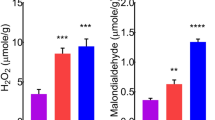Abstract
Background
Cement factories are major pollutants for the surrounding areas. Inert dust deposition has been found to affect photosynthesis, stomatal functioning and productivity. Very few studies have been conducted on the effects of cement kiln dust on the physiology of perennial fruit crops. Our goal was to study some cement dust effects on olive leaf physiology.
Methods
Cement kiln dust has been applied periodically since April 2003 onto olive leaves. Cement dust accumulation and various leaf physiological parameters were evaluated early in July 2003. Measurements were also taken on olive trees close to the cement factory.
Results
Leaf dry matter content and specific leaf weight increased with leaf age and dust content. Cement dust decreased leaf total chlorophyll content and chlorophyll a/chlorophyll b ratio. As a result, photosynthetic rate and quantum yield decreased. In addition, transpiration rate slightly decreased, stomatal conductance to H2O and CO2 movement decreased, internal CO2 concentration remained constant and leaf temperature increased.
Discussion
The changes in chlorophyll are possibly due to shading and/or photosystem damage. The changes in stomatal functioning were possibly due to dust accumulation between the peltates or other effects on stomata.
Conclusions
Dust (in this case from a cement kiln) seems to cause substantial changes to leaf physiology, possibly leading to reduced olive productivity.
Recommendations
Avoidance of air contamination from cement factories by using available technology should be examined together with any possible methodologies to reduce plant tissue contamination from cement dust.
Perspectives
Longterm effects of dust (from cement kiln or other sources) on olive leaf, plant productivity and nutritional quality of edible parts could be studied for conclusive results on dust contamination effects to perennial crops.
Similar content being viewed by others
References
Angelopoulos K, Dichio B, Xiloyannis C (1996): Inhibition of photosynthesis in olive trees (Olea europaea L.) during water stress and rewatering. J Exp Bot 47, 1093–1100
Bongi G, Mencuccini M, Fontanazza G (1987): Photosynthesis of olive leaves: effect of light flux density, leaf age, temperature, peltates, and water vapour pressure deficit on gas exchange. J Amer Soc Hort Sci 112, 143–148
Farmer AM (1993): The effects of dust on vegetation — A review. Environ Pollut 79, 63–75
Gucci R, Massai R, Casano S, Costagli G (1999): The effect of leaf age on CO2 assimilation and stomatal conductance of field-grown olive trees. Acta Hort 474, 289–292
Hall DO, Scurlock JMO, Bolhar-Nordenkampf HR, Leegood RC, Long SP (1993): Photosynthesis and Production in a changing environment: A field and laboratory manual. Chapman and Hall, London, UK
Larcher W (1995): Physiological plant ecology. Springer-Verlag, Berlin, Germany
Liu JL, Du M, Shang KY, Chen SY, Xu HB, Xie MY (1997): The effects of cement dust pollution on rice, rape and soil. J Plant Resources Environ 6, 42–47
Lepedus H, Cesar V, Suver M (2003): The annual changes or chloroplast pigments content in current-and previous-year needles or Norway spruce (Picea abies L. Karst.) exposed to cement dust pollution. Acta Botanica Croatica 62, 27–35
Mandre M, Tuulmets L (1997): Pigment changes in Norway spruce induced by dust pollution. Water Air Soil Pollut 91, 247–258
Mandre M, Ots K (1999): Growth and biomass partitioning of 6-year-old spruces under alkaline dust impact. Water Air Soil Pollut 114, 13–25
Nunes A, Brugnoli E, Maguas C, Correia O (2004): Effect of dust deposition on foliar absorbance of Mediterranean species. Rev Biologia Lisboa 22, 143–151
Pandey DD, Kumar S (1996): Impact of cement dust pollution on biomass, chlorophyll, nutrients and grain characteristics of wheat. Environ Ecol 14, 872–875
Proietti P, Famiani F (2002): Diurnal and seasonal changes in photosynthetic characteristics in different olive (Olea europaea L.) cultivars. Photosynthetica 40, 171–176
Saralabai VC, Vivekanandan M (1997): Effect of electrostatic precipitator dust (EPS) on pollen fertility and crop productivity. Rev Brasileira Fisiologia Vegetal 9, 67–69
Satao RN, Kene HK, Nalamwar RV, Ulemale RB (1993): Effect of cement dust pollution on growth and yield of cotton. Ann Plant Physiol 7, 73–77
Wintermans IF, Mots A (1965): Spectrophotometric characteristics of chlorophylls a and b and their pheophytins in ethanol. Bioch Biophys Acta 109, 448–453
Zanichelli D, Carloni F, Hasanaj E, D’Andrea N, Filippini A, Setti L (2006): Production of ethanol by an integrated valorisation of olive oil byproducts: The role of phenolic inhibition. Environ Sci Pollut Res, OnlineFirst 〈DOI: http://dx.doi.org/10.1065/espr2006.06.316〉
Author information
Authors and Affiliations
Corresponding author
Additional information
ESS-Submission Editor: Prof. Dr. Stefan Trapp (stt@er.dtu.dk)
Rights and permissions
About this article
Cite this article
Nanos, G.D., Ilias, I.F. Effects of inert dust on olive (Olea europaea L.) leaf physiological parameters. Env Sci Poll Res Int 14, 212–214 (2007). https://doi.org/10.1065/espr2006.08.327
Received:
Accepted:
Published:
Issue Date:
DOI: https://doi.org/10.1065/espr2006.08.327




